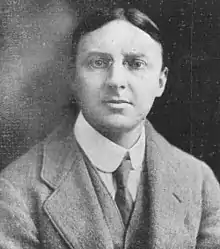
Arthur Lindsay Sadler (1882–1970) was Professor of Oriental Studies at the University of Sydney.[1]
Life and career
Sadler was born in Hackney, London and educated at the University of Oxford (B.A., 1908; M.A., 1911).[1] From 1909 he worked in Japan as a teacher and was an active member of the Asiatic Society of Japan.
Sadler was the Professor of Oriental Studies at the University of Sydney from 1922 to 1948 (his predecessor being the foundation professor, James Murdoch).[2] He also taught at the Royal Military College of Australia.[2]
His publications included an English translation of Hōjōki and Heike Monogatari under the title of The Ten Foot Square Hut and Tales of the Heike (1928; 1972); The Art of Flower Arrangement in Japan (1933); Cha-No-Yu: The Japanese Tea Ceremony (1933; 1962); Maker of Modern Japan: The Life of Tokugawa Ieyasu (1937); an English translation of Daidōji Yūzan's Budo Shoshinshu under the title of The Code of The Samurai (1941; 1988); A Short History of Japanese Architecture (1941); an English translation of The Articles of Sun Tzu, of The Precepts of Sima Rangju and of Wu Qi on the Art of War as Three Military Classics of China (1944); and A Short History of Japan (1946).
One of Sadler's teachers at Oxford in the early 1900s had been Dr. Griffithes Wheeler Thatcher[3] and, when in 1936 the latter was appointed the first head of the Department of Old Testament Language and Literature at the University of Sydney, one of four departments offering courses for the new Bachelorate of Divinity there, Sadler assisted in lecturing duties and in other ways.[4]
After retirement from the University of Sydney (his successors in the professorship being John Kennedy Rideout in 1948[2] and then by A. R. Davis in 1955),[5] Sadler returned to England and settled in the Essex village of Great Bardfield. At Bardfield he became friendly with several of the Great Bardfield Artists. He spent his final years living in Stubbards Croft in Great Bardfield and later at Buck's House in the same village.
Personal life
In 1916 he married Eva Botan Seymour (1893-1978), an Anglo-Japanese, in Tokyo. They would have no children.[6]
References
- 1 2 Joyce Ackroyd, Sadler, Arthur Lindsay (1882–1970), Australian Dictionary of Biography, adb.anu.edu.au. Retrieved 30 November 2020.
- 1 2 3 "Long Neglect of Study of Oriental Languages", The Sydney Morning Herald, 28 March 1955, p. 2.
- ↑ Thatcher, Griffithes Wheeler (1863–1950), adb.anu.edu.au. Retrieved 19 October 2022.
- ↑ E. C. B. MacLaurin and the Dept. of Semitic Studies of the University of Sydney", Australian Journal of Biblical Archaeology. Retrieved 19 October 2022.
- ↑ Benjamin Penny, "Preface to A.R. Davis Reprints", East Asian History, Number 38, February 2014, eastasianhistory.org. Retrieved 30 November 2020.
- ↑ Maria (Connie) Tornatore-Loong, Exhibition Preview: Japan in Sydney: Arthur Lindsay Sadler, Japan and Australian Modernism, 1920s - 1930s, The Journal of the Asian Arts Society of Australia,Vol. 20, No. 1, March 2011, pp. 20-21. Retrieved 30 November 2020.
Further reading
- "The Study of Japan in Australia : A Unique Development over Eighty Years", Japanese Studies Around the World, 2003 volume, 30 May 2003, pp. 34–40.
- "Prologue: Australia Must Prepare", in: William Sima, China & ANU: Diplomats, Adventurers, Scholars, Canberra: Australian Centre on China in the World: Australian National University Press, 2015, pp. 8–11.
External links
- The ten foot square hut, and Tales of the Heike; being two thirteenth-century Japanese classics, the "Hojoki" and selections from the "Heike monogatari", translated by A. L. Sadler (Charles E. Tuttle Company, 1972 reprint)